Port Infrastructure Market Research - 2030
The global port infrastructure market size was valued at $148.1 billion in 2020, and is projected to reach $243.1 billion by 2030, growing at a CAGR of 4.9% from 2021 to 2030.
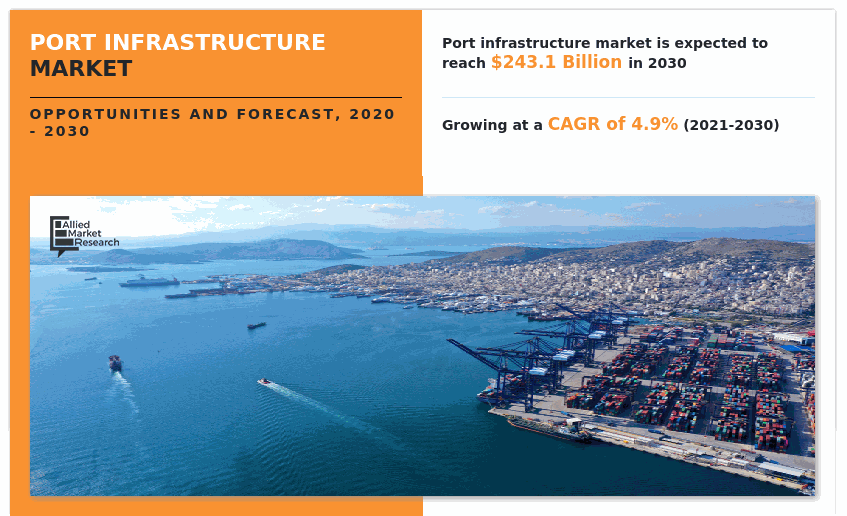
Market Dynamics
Port infrastructure is the foundation of port operations used for servicing ships, cargo, and passengers passing through the port. Expanding port infrastructure requires capital-intensive investments, long lead times, and long-term planning. Port infrastructure design needs to anticipate the needs of shipping, logistics, and transportation sectors. Increase in government investments on port infrastructures to ensure safe and efficient economic activities is expected to drive the global port infrastructure market.
In addition, development and need for shipment of liquefied natural gas through sea is expected to contribute to increase in demand for the market. Moreover, many industries depend on sea shipments for importing or exporting goods across the world. Airway transport of goods is costly as compared to waterway. This is further expected to boost the growth of the port infrastructure market during the forecast period.
However, construction and maintenance of port infrastructure involves heavy capital investment. This hampers the growth of the market. Moreover, trade barriers are restraining the port infrastructure market growth. Trade barrier such as tariff, which is tax imported on imported goods. For instance, import in the U.S. from China is more as compared to export to China. Hence, the U.S. Government implemented tariff tax system to control imports and to save domestic businesses. Tariff makes imported goods expensive due to tariff import reduces. Hence, this affects port transportation and shipment.
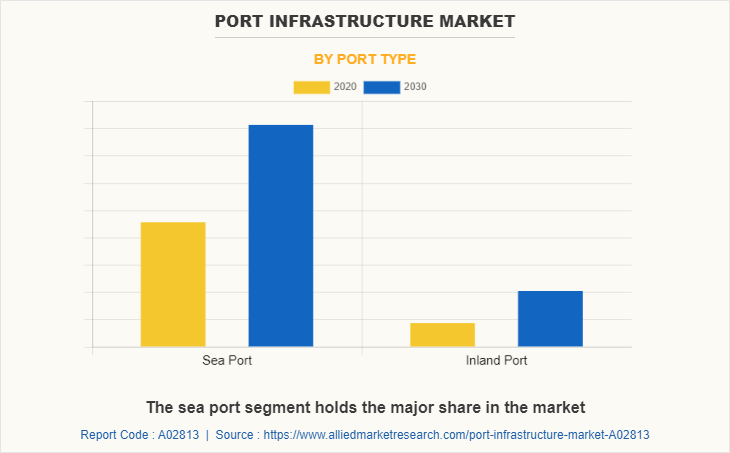
Furthermore, during the outbreak of the COVID-19 pandemic, construction, manufacturing, hotel, and tourism industries were majorly affected. Manufacturing activities were halted or restricted. Construction and transportation activities, along with their supply chains, were hampered on a global level. This led to decline in construction of ports as well as their demand in the market, thereby restraining the growth of the port infrastructure industry. Conversely, industries are gradually resuming their regular manufacturing and services. This is expected to lead to re-initiation of the companies at their full-scale capacities, which helped the port infrastructure market share to recover by end of 2021.
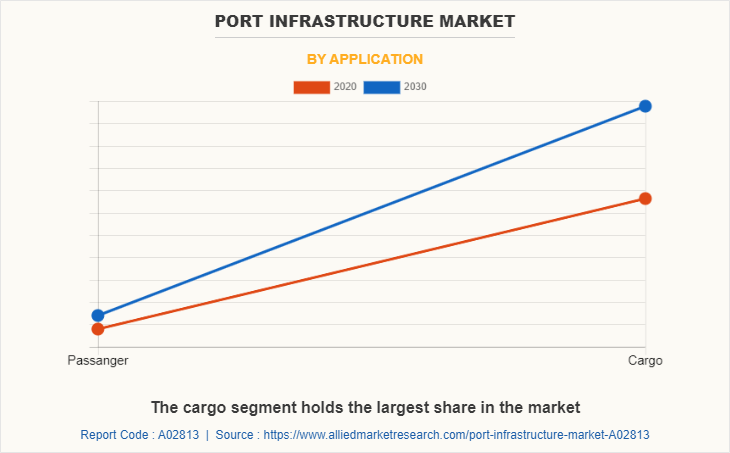
Efficient trade activities promote economic growth of a country. Thus, sea ports play a crucial role in economic activities especially in the coastal areas. With increase in throughput of passengers travelling via sea and goods transport every year, the need for appropriate and improved port infrastructure market has increased significantly. This scenario is expected to boost the global port infrastructure market opportunity. In addition, current developments and automation in port infrastructure, such as use of IoT and AI for shipment and transport management can reduce the delivery time required for waterway transport. Thus, this acts as an opportunity for the growth of the market.
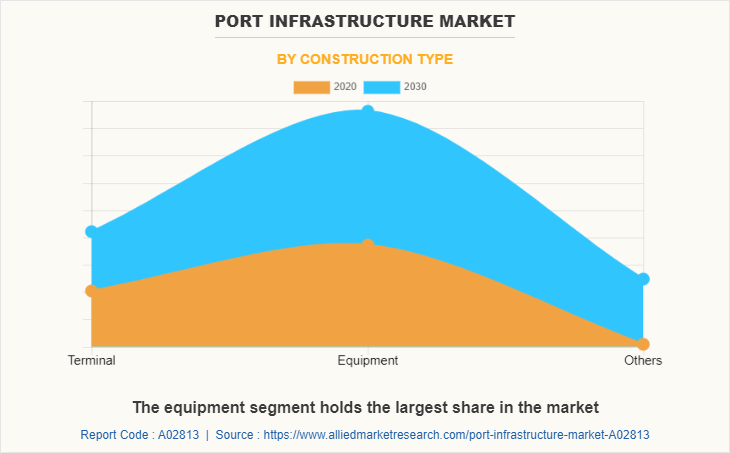
Segmental Overview
The port infrastructure market is segmented into port type, application, construction type and region. On the basis of port type, the market is classified into sea port and inland port. Depending on application, it is segregated into passenger and cargo.
By construction type, it is categorized into terminal, equipment, and others.
Region wise, the global port infrastructure market analysis is considered across North America (the U.S., Canada, and Mexico), Europe (the UK, France, Germany, Italy, and rest of Europe), Asia-Pacific (China, Japan, India, South Korea, and rest of Asia-Pacific), and LAMEA (Latin America, the Middle East, and Africa).
On the basis of port type, in 2020, the sea port segment dominated the market, in terms of revenue, whereas the inland port segment is expected to witness growth at the highest CAGR during the forecast period.
As per application, in 2020, the cargo segment led the port infrastructure market, however, the passenger segment is expected to exhibit highest CAGR in the near future.
By construction type, the equipment segment led the market in 2020, in terms of revenue; however, the others segment is anticipated to register highest CAGR during the forecast period. Region wise, Asia-Pacific garnered the highest revenue in 2020; however, LAMEA is anticipated to register highest CAGR during the forecast period.
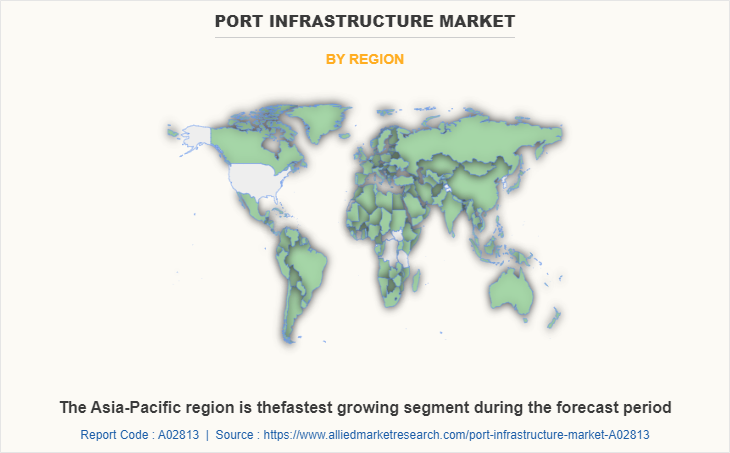
Competition Analysis
The major players profiled in the port infrastructure market include Adani Ports and SEZ, APM Terminal, AECOM, Colas, Essar Ports Ltd., IL&FS Engineering & Construction Company Ltd., Larsen & Toubro Ltd., Man Infraconstruction Ltd., Ramboll, and WSP Global Inc. Major companies in the market have adopted acquisition, business expansion, and agreement as their key developmental strategies to offer better products and services to customers in the port infrastructure market.
Key Benefits For Stakeholders
- This report provides a quantitative analysis of the market segments, current trends, estimations, and dynamics of the port infrastructure market forecast from 2020 to 2030 to identify the prevailing the market opportunities.
- The market research is offered along with information related to key drivers, restraints, and opportunities.
- Porter's five forces analysis highlights the potency of buyers and suppliers to enable stakeholders make profit-oriented business decisions and strengthen their supplier-buyer network.
- In-depth analysis of the market segmentation assists to determine the prevailing market opportunities.
- Major countries in each region are mapped according to their revenue contribution to the global market.
- Market player positioning facilitates benchmarking and provides a clear understanding of the present position of the market players.
- The report includes the analysis of the regional as well as global port infrastructure market trends, key players, market segments, application areas, and market growth strategies.
Port Infrastructure Market Report Highlights
| Aspects | Details |
| By Port Type |
|
| By Application |
|
| By Construction Type |
|
| By Region |
|
| Key Market Players | Man Infraconstruction Ltd., APM Terminal, Larsen & Toubro Ltd., WSP Global Inc., AECOM, IL&FS Engineering & Construction Company Ltd., Adani Group, Ramboll, Essar Ports Ltd., Colas |
Analyst Review
The port infrastructure market witnessed a huge demand in Asia-Pacific followed by North America. The highest share of the Asia-Pacific market is attributed to increase in import and export business.
As per the CXOs, transporting products by air is more expensive than transporting commodities by water, which is expected to drive the growth of the market.
In addition, trade barrier such as tariff, which is tax imported on imported goods makes imported goods expensive. Hence, this affects import and reduces port transportation and shipment. For instance, imports in the U.S. by China is higher as compared to export to China. The U.S. Government implemented tariff tax system to control imports and to save domestic businesses. Efficient trade activities promote economic growth of a country. Thus, sea ports play a crucial role in economic activities especially in the coastal areas. With increase in throughput of passengers travelling via sea and goods transport every year, the need for appropriate and improved port infrastructure has increased, which, in turn, is expected to foster the market growth.
Moreover, market leaders are investing millions of dollars to automate port by using IoT and AI systems to improve logistics and management of port. These technological advancements and infrastructural requirements in port infrastructure are likely to create lucrative opportunities for market players.
The CXOs further added that major companies in the market have adopted acquisition, business expansion and agreement as their key developmental strategies to offer better products and services to customers.
The port infrastructure market was valued at $148,147.3 million in 2020, and is expected to reach $243,086.3 million by 2030, registering a CAGR of 4.9% from 2021 to 2030.
The forecast period considered for the global port infrastructure market is 2021 to 2030, wherein, 2020 is the base year, 2021 is the estimated year, and 2030 is the forecast year.
To get latest version of global port infrastructure market report can be obtained on demand from the website.
The top companies holding the market share in the global port infrastructure market report include Adani Ports and SEZ, APM Terminal, AECOM, Colas, Essar Ports Ltd., IL&FS Engineering & Construction Company Ltd., Larsen & Toubro Ltd., Man Infraconstruction Ltd., Ramboll, and WSP Global Inc.
The top ten market players are selected based on two key attributes - competitive strength and market positioning
The report contains an exclusive company profile section, where leading 10 companies in the market are profiled. These profiles typically cover company overview, geographical presence, market dominance (in terms of revenue and volume sales), various strategies and recent developments.
The base year considered in the global port infrastructure market report is 2020.
Loading Table Of Content...



